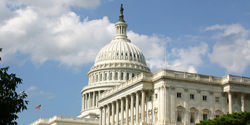New efficiency standards for incandescent light bulbs went into effect on Jan. 1, 2012. Despite the lack of federal funding to enforce the law, domestic lighting manufacturers are required to abide by it, and the overwhelming majority are doing so by producing more energy-efficient bulbs.

The new year also brought the expiration of several energy efficiency tax incentives, including: the Home Energy Efficiency Tax Credits for 2011, the New Energy Efficient Home Credit and the Energy Efficient Appliance Credit. Although Congress did not address these expiring tax incentives in 2011, this year lawmakers may consider extending them along with energy-related credits set to expire at the end of 2012.
On Dec. 17, 2011, Congress narrowly averted a government shutdown by approving an omnibus spending package that funds the Department of Energy (DOE) and other agencies for fiscal year 2012.
The results are a mixed bag for proponents of energy efficiency: Although several energy efficiency appropriations programs received increases over original allocations, Congress rescinded funding for enforcement of the efficient lighting standards and dramatically cut the Weatherization Assistance Program.
“The Alliance to Save Energy is deeply disappointed about the counter-productive action taken on lighting efficiency and weatherization assistance. Regardless of certain economic and political hurdles, we are optimistic about promoting critical energy efficiency investments by working collaboratively with our bipartisan allies to continually build support in 2012,” said Alliance to Save Energy Director of Government Relations Rob Mosher.
Enforcement for Lighting Standards Blocked
Despite repeated advocacy efforts calling for funding to enforce the efficient lighting standards, the final omnibus bill retained a controversial House-passed rider that blocks DOE from enforcing the standards. These standards were enacted with wide bipartisan backing in 2007, including nearly unanimous support from domestic lighting manufacturers, such as Phillips and Osram Sylvania, who already have invested millions of dollars to make new incandescent bulbs that meet the standards. The current law is scheduled to take effect on Jan. 1, 2012.
“Congress is voting to prohibit the Department of Energy from spending money to enforce a law that it ‘put on the books’ in 2007, namely technology-neutral, light bulb efficiency standards that can save Americans money and energy,” said Alliance to Save Energy President Kateri Callahan.
What other effects might the funding limitation have? Senate Energy and Natural Resources Chairman Jeff Bingaman (D-N.M.), original author of the 2007 law, said the decision is likely to have “little practical consequence on which incandescent light bulbs are available in stores because, starting Jan. 1, it will be illegal to produce or import the inefficient, wasteful bulbs in the United States.”
Limiting the federal enforcement mechanism could spur greater uncertainty in the marketplace, as states may choose to individually implement standards creating a patchwork of competing regulations for manufacturers. The absence of federal enforcement also could increase imports of inefficient foreign bulbs, undermining the competitiveness of and investments made by U.S. manufacturers.
Weatherization Assistance Program Faces Steep Cuts
Taking a hard hit in the FY 2012 omnibus appropriations bill, the Weatherization Assistance Program (WAP) received a 63% cut compared to the enacted FY 2011 allocation, putting WAP at its lowest level of funding since 1978.
The FY 2012 cut comes in the face of WAP’s recent success in creating jobs and helping low-income American families reduce their energy bills. In December 2011, DOE reached its goal of weatherizing 600,000 homes through the American Recovery and Reinvestment Act (ARRA) supported by WAP. This achievement is projected to save $320 million nationwide in its first year – an average savings of more than $400 to low-income families on annual heating and cooling bills, according to DOE estimates. The program also is supporting more than 14,000 jobs nationwide.
In spite of disappointing cuts to WAP, the program is expected to continue utilizing ARRA funds, which have been extended past the March 31, 2012 deadline. However, once ARRA funding has been exhausted, additional investments will be necessary to sustain WAP and its important energy-saving benefits.
Funding for FY 2012 Energy Efficiency Programs
Overall, the omnibus spending package provides $25.75 billion for DOE, which is $1 billion more than the amount in the House-passed Energy and Water Appropriations bill and $200 million more than what was proposed by Senate appropriators. The DOE’s Office of Energy Efficiency and Renewable Energy (EERE) will receive $1.815 billion.
“Recognizing the constrained economic environment, the Alliance to Save Energy was pleased that Congress largely supported the EERE program overall in the FY 2012 appropriations process as we had advocated,” said Alliance Senior Vice President of Policy and Research Floyd DesChamps.
View a summary of the funding for energy efficiency programs as part of EERE in the chart below and the complete funding chart for FY 2012 federal energy efficiency programs.
| DOE, EERE Office (Energy and Water Appropriations) | FY 2012 Omnibus Funding in Millions of Dollars | Change from FY 2011 Plan |
| Building Technologies | 220 | 5% |
| Energy Innovation Hub: Buildings | 24.3 | 0% |
| Solid State Lighting R&D | 25.832 | 0% |
| Industrial Technologies | 116 | 7% |
| Vehicle Technologies | 330 | 10% |
| Federal Energy Management | 30 | -1% |
| State Energy Program | 50 | 0% |
| Weatherization Assistance | 65 | -63.00% |
| Related DOE Programs |
|
|
| Hydrogen and Fuel Cells | 104 | 6% |
| Electricity R&D | 99.49 | -5% |
| ARPA-E | 275 | 53% |
| Loan Guarantees – EE+RE | 0 | -100% |





